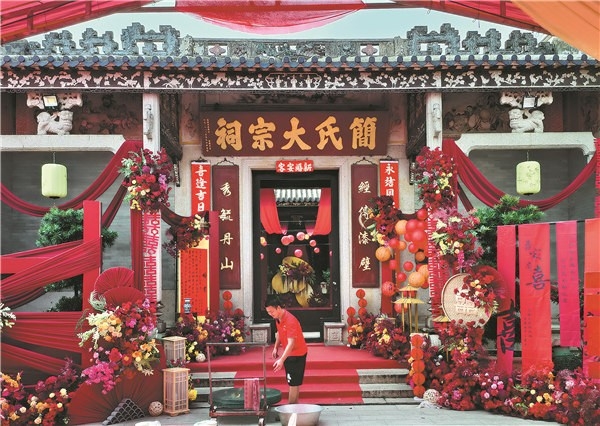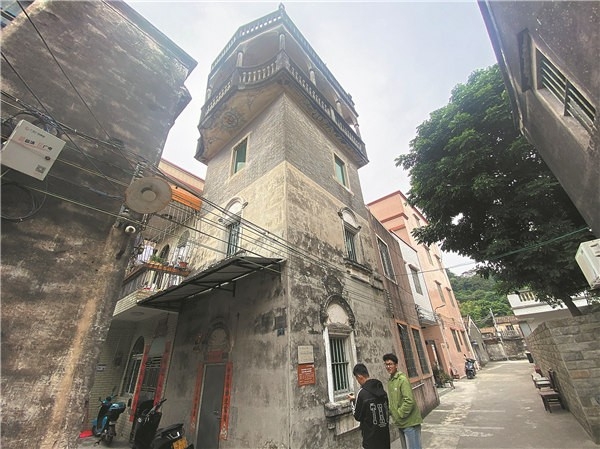
Restoration funds give new lease of life to historical structures, Zheng Caixiong reports in Guangzhou. [Photo provided to China Daily]
The restoration of a historical arch has brought many benefits, not least putting a spring back in the step of Liu Jiang.
With no small amount of pride and with obvious delight, the staff member of the Nanlang subdistrict cultural service center in Zhongshan city, Guangdong province, these days happily introduces the historical arch to visitors.
The arch, built during the Qing Dynasty (1644-1911), has both its wall base and frame constructed of red sandstone.
Due to the erosion of time, the green brick wall surface became moldy and blackened, the red sandstone wall surface weathered and damaged, while the clay sculpture on the top had also seen better days. It wasn't just cosmetic, there were definite safety hazards.
Due to lack of maintenance funds and experience, stainless steel protective fences were erected to prevent visitors and pedestrians from going too close or touching the arch.
Things changed in 2023 when the city government took the lead in Guangdong province in implementing the full coverage of the annual maintenance system for immovable cultural relics. In total, the city in the Guangdong-Hong Kong-Macao Greater Bay Area budgeted 5.46 million yuan ($767,130) to repair its immovable cultural relics last year.
Meanwhile, it introduced a trial management method for the annual maintenance subsidy funds and established an annual maintenance subsidy fund for daily maintenance and repair of the immovable relics.
Last year, Nanlang subdistrict successfully applied for 41,000 yuan from the city's annual maintenance subsidy fund and in March, successfully repaired the arch following the principle of "repairing the old as it is".
The stainless steel protective fences of the arch were removed, the wall cleaned and filled, and the tile surface and clay sculptures also grouted and restored, Liu says.
The restoration of the arch is not an isolated endeavor.

A restored diaolou, a multistory watchtower-style residential building, in the city. [Photo provided to China Daily]
Huang Junwei, owner of a diaolou, a multistory watchtower-style residential building, located in Zhongshan's Torch High-Tech Industrial Development Zone, says that the guardrails on one roof of the diaolou had become detached exposing steel bars. The structure was crumbling, posing a danger to passersby.
"Later, the zone's cultural relics management department applied for the repair funds from the city's annual maintenance subsidy to help fix the diaolou, protect the relic and remove the safety hazard," he says.
According to Liu, the establishment of the annual maintenance subsidy fund indicated that Zhongshan has shifted the protection concept of immovable cultural relics from "emphasizing the repairs and restoration of cultural relics and neglecting daily maintenance" to "mainly focusing on daily maintenance and minimizing repairs as much as possible".
After the Sun Yat-sen memorial pavilion in Haochong village in Nanlang subdistrict was repaired with the city's annual maintenance subsidy fund, it has now become a favored destination for villagers to chat after meals or while waiting for buses, Liu says.
"Many villagers gave a thumbs-up to the repairs and maintenance of the village's cultural relics," he says, adding that previously he used to be scolded by the elderly in the village for failing to protect the hamlet's relics when he arrived on inspection tours.
Liu says with the aid of the city's annual maintenance subsidy fund, his center had completed repairs and maintenance for more than 100 immovable cultural relics under its jurisdiction, as of the end of June.
According to Wu Rongchao, director of the cultural heritage department with the Zhongshan Bureau of Culture, Broadcast, Television and Tourism, the city achieved full coverage of the annual maintenance system for immovable cultural relics in the entire city. And the system was awarded as one of the top 10 cases of high-quality development of cultural relics in the country in 2023.
The city's cultural relics are not only abundant in quantity, but also diverse in type, covering all major categories, such as ancient cultural sites, tombs, architecture, stone carvings, temples, important historical sites and representative buildings of modern times, he says.
Zhongshan has a total of 568 immovable cultural relics that have been recognized and made public, including three national key cultural relics and 24 provincial cultural relics, according to Wu.
"Relevant departments have, so far, completed a total of 184 daily repair and maintenance projects for the city's immovable cultural relics," Wu says.

A comparison of a neighborhood door before restoration (right) and after (left). [Photo provided to China Daily]
The city still has a large number of immovable cultural relics that have not been listed as cultural relics that need to be protected yet, causing difficulty in protecting the city's immovable cultural relics, he adds.
"Many immovable cultural relics pose safety hazards with termite infestation, water leakage, cracked walls, damaged building components and old water supply pipelines," he says.
If maintenance cannot be carried out in time and repairs are postponed, resulting in more damage and need for extensive repairs, it not only requires a huge investment, but also leads to the loss of historical information and the weakening of authenticity of cultural relics, according to Wu. And the value of cultural relics cannot be replicated, with each relic having its own historical, scientific and artistic values.
Diaolou, which were usually built by overseas Chinese in the late Qing Dynasty till the 1930s, were structures that combined Chinese and Western architectural styles, while the ancestral halls have always been traditional cultural memorial sites, demonstrating traditional culture and customs.
After the implementation of the annual maintenance system for immovable cultural relics, the preservation status of these structures in the city has greatly improved.
Long Mengjun, director of the publicity and cultural service center of Torch High-Tech Industrial Development Zone, says that the full coverage of the city's annual subsidy funds has effectively solved the difficulty of property owners and custodians being unable to bear the repair and maintenance costs and maximize the preservation and continuity of the authenticity and integrity of cultural relics.
About Zhongshan News Business Culture Services
Copyright © 2018-2019 Zhongshan Daily Newspaper Group. All rights reserved. Presented by zsnews.cn